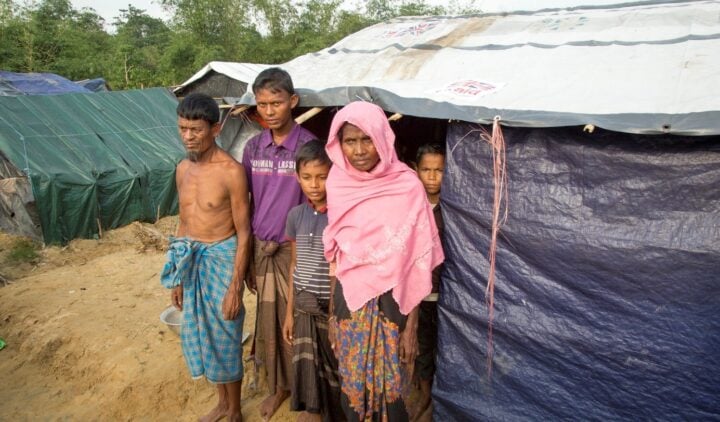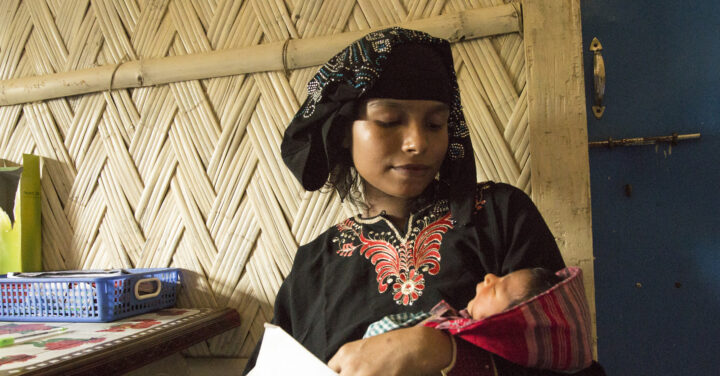Mohammed Masudur Rahman, Economist, UNHCR; Sarah Baird, Associate Professor of Global Health and Economics, George Washington University; and Jennifer Seager, Assistant Professor of Global Health and Economics, George Washington University.
Rohingya refugees and Bangladeshi adolescents report being impoverished due to the COVID-19 pandemic, with girls experiencing the impact more intensely. We explore the policy priorities to address these challenges and help adolescents weather the pandemic.
 Members of the Rohingya community in Bangladesh © Anna Dubuis/DFID
Members of the Rohingya community in Bangladesh © Anna Dubuis/DFID
For the 860,000 Rohingya refugees and thousands of impoverished Bangladeshis living in Cox’s Bazar, COVID-19 has intensified existing hardships. Besides the health risks from the virus, lockdowns to mitigate its spread have disrupted self-reliance and income-generating activities and reduced access to basic services.
The containment measures will likely have multidimensional effects on young people. In order to inform policies to help youth groups weather the effects of the pandemic, the Gender and Adolescence: Global Evidence (GAGE) study looked at the prolonged lockdown’s impact on adolescents’ education, nutrition and overall well-being – all essential elements of building human capital for more resilient futures.
A sample of 725 Rohingya adolescents living in camps and 1,097 Bangladeshi adolescents living in host communities were surveyed over the phone from May–June 2020, with 30 adolescents engaged via in-depth qualitative virtual interviews. The study looked at overall impacts, and at differences by gender and age – young adolescents between 10-14 years old and older ones between 15-19 years old.
Food insecurity emerged as one of the most severe consequences of the pandemic. Among adolescents, 23% of Bangladeshis and 17.7% of Rohingyas said they felt hungrier in the past four weeks than prior to COVID-19. In both populations, girls were more likely to report hunger (27% girls vs 18% of boys in host communities; and 22% girls vs 14% of boys in camps). Nearly all participants of the qualitative interviews said less food is available to them. A 15-year-old male said, ‘[In the past] we could have three meals per day. But we struggle with having two meals now.’
The prevalence of hunger is supported by findings in the Joint Multi-Sector Needs Assessment (J-MSNA) 2020, which found that the percentage of households with a poor food consumption score jumped from 5% to 15% in refugee communities and 3% to 8% in host communities. Households without an adult male or a male of working-age were more likely in the J-MSNA to have reported adopting food-related coping strategies.
Sources of income for households have also reduced. Among the 10% of adolescents who were working prior to COVID-19, 85% of them say paid work has either stopped or decreased, with 57% of Bangladeshis reporting not having restarted work compared to 75% of Rohingya. At the time of data collection, only 2% of adolescents across host communities and camps, nearly all males, has engaged in new work since COVID-19.
Education of adolescents has been substantially disrupted. A nationwide mandate for school closures in March led to the closing of schools in Cox’s Bazar and learning centres in the camps. Before COVID-19, 75% of adolescents in host communities were enrolled in formal school. After school closures, just 6% say that their school is providing learning support, 14% say they have been in contact with a teacher in the week prior to the survey, and 6% report using internet or media sources to continue distance learning. On a brighter note, 76% of school-going adolescents say they receive family learning support during school closures, though boys are more likely to receive such assistance compared to girls (82% vs 71%).
In camps, 29% of the adolescents were enrolled in non-formal school before COVID-19. After the closure of learning centres, less than 1% of adolescents enrolled in informal school report using the internet or media to continue learning. Family support for learning is encouraging, with 70% reported receiving such support.
Health wise, most Rohingya and Bangladeshi adolescents report to be in good or very good health (92% and 87%, respectively). However, 10% say their health has deteriorated since the start of COVID-19, with boys nearly twice as likely to report this as girls (12% and 7%, respectively). Linked to this, 16% of the sample had had one COVID-19-related symptom in the two weeks prior to the survey.
An important aspect of health is psychosocial wellbeing. Although moderate to severe depression is low, 78% of adolescents are highly or moderately worried and anxious about COVID-19. The data from qualitative interviews also suggest that due to existing cultural mobility restrictions placed on females – primarily in camps – boys are most impacted by lockdown orders, lamenting a loosening of friendships.
Across camp and host communities, 8% of adolescents report increased gender-based violence in the community. Boys specifically report concerns around escalation in police and military violence when enforcing lockdown measures (38% of boys vs 22% of girls).
The pandemic may have protected some adolescents from child marriage. Among older adolescents, twice as many girls as boys say that the pressure to marry has decreased (14.4% boys vs 33% girls) since COVID-19. In the younger cohort, 16% of girls say the pressure to marry has decreased compared to 11% of boys. This protective effect, though small and deserving of more research, is important: data suggest that across locations, married girls are more than twice as likely as unmarried girls to report that gender-based violence has increased in the community during COVID-19 (22% and 9%, respectively).

Young mother from the Rohingya community in Bangladesh © DFID/Anna Dubuis
Policy and programming priorities to prevent lasting negative impacts
Significantly heightened vulnerabilities facing adolescent girls and boys in Cox’s Bazar point to a number of policy and programming priorities in terms of the package of support young people need to foster their resilience during the pandemic.
First, tackling food insecurity is urgently needed. Even with continued food assistance to Rohingya refugees and additional targeting of host community residents, adolescents and their families are reporting increased food insecurity. The loss of income, coupled with higher prices in the periodically open markets, has led to a decrease in food intake. Food security sector partners should continue to scale up and increase in-kind and voucher food support in the camps, and both food and cash support in host communities, informed by a detailed gender- and age-needs analysis.
Also pressing is resuming schools, vocational learning and income-generating skills training during the closure of learning centres. For refugees, education sector partners should bolster remote learning material and methodologies to alleviate interruptions to learning. Tailored material should be directed to those adolescents who are not able to rely on family support. Furthermore, addressing limitations to digital connectivity in the camps are necessary to promote access to information and online learning. These efforts should be coupled with the prioritisation of WASH and other infrastructure to ensure that educational centres may safely reopen.
For Bangladeshi adolescents, it is necessary to continue scaling up remote learning disseminated via mobile phones, radio and television plus material distribution. Establishing a medium- to long-term recovery strategy to address the educational gaps created by the pandemic will best mitigate disruptions to learning.
Last but not least, it is essential that public communication messaging on age- and gender-based protection risks – including child marriage and child labour – reach all families. Robust reporting channels need to be established and maintained, including in-person options, phone and online hotlines, as well as provisioning made for legal and medical support for adolescents facing protection risks.
Note: the findings outlined above are discussed in greater detail in this policy brief that is part of a cross-country series designed to share emerging findings in real time from quantitative surveys and qualitative interviews with adolescents in the context of COVID-19. The young people involved are part of the Gender and Adolescence: Global Evidence (GAGE) programme’s longitudinal research in Cox’s Bazar. UNHCR provided technical review of the policy brief and feedback, taking into account developments on the ground.
